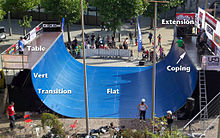halfpipe
A halfpipe is a sports facility made of concrete , wood , metal or snow in the form of a tube that is halved along its longitudinal axis. It is used in various sports, mainly skateboard , snowboard , stunt scooter and aggressive inline , as the basis for artistic maneuvers and has meanwhile become an Olympic discipline in the snow . There are also half halfpipes, which are called quarterpipes (English for "quarter tube").
construction
The roadway of a halfpipe originally consists of transition , vert , coping and table . The transition describes a semicircle with a radius of about 3.5 to 3.7 meters and leads to the vertical vert above it. The vert now measures between 50 and 70 centimeters. At the top, the vert is bounded by the coping, a protruding metal tube. The table touches the vert at the coping and is the platform from which the athlete enters the halfpipe.
When passing through the transition of a half pipe, the athlete can increase the speed by putting pressure on the sports equipment. This effect, similar to that on a swing , is called "pumping". The athlete can drive up the vert at high speed, jump vertically over the edge of the halfpipe, perform an artistic maneuver (for example a turn around the longitudinal axis) in the air and land again along the vert according to gravity . The maneuver is known as a "trick". In half-pipe competitions, referees (often called "judges") evaluate the quality of the tricks.
In modern halfpipes, the transition is divided into two halves and connected to a horizontal section of the road, the flat . Some halfpipes are provided with an extension , an elevated point that gives additional momentum when entering. A variant of the extension is the roll-in with a round transition between table and vert.
skateboard
The basis for the halfpipe, which has also been adopted in other sports, was discovered in the 1970s by the Zephyr Team (also Z-Boys ) skateboarding association in the form of empty swimming pools. Tony Alva is considered to be the first skateboarder to leave the pool's edges, jump out and back in and thus lay the foundation for today's halfpipe discipline. However, because a swimming pool was not to be reproduced in rapidly growing competitions, these were soon replaced by wooden ramps. Here, too, constant developments took place, which led to the current shape of the halfpipe.
A variant of the halfpipe that is widespread in skateboarding is the mini ramp , which is often incorrectly referred to as a halfpipe. Miniramps do without the vert. With a height of about one to two meters, those constructions are significantly smaller than real halfpipes, which start at an average of three meters. Experienced skateboarders can also ride mini ramps without pads (protective equipment) and are therefore very popular.
Successful skaters in the halfpipe are or were Tony Hawk , Andy MacDonald, Mike McGill , Tony Alva, Sergie Ventura, Takeshi Yasutoko , Fabiola da Silva and Sandro Dias .
Snowboard
In the 80s, the snowboard movement was heavily influenced by skateboard culture. Therefore, followers usually formed the first versions of the halfpipe themselves, which, however, did not allow many maneuvers at first. Only the strong development in the 90s prompted the industry to develop specific machines which enable completely symmetrical constructions in a relatively short time. Modern competition halfpipes are having on groomers mounted milling made of snow and ice.
In contrast to ramps for roller sports, the halfpipes for snowboards made of snow are long and sloping along their cylinder axis , so that the energy to maintain the pace (viewed when driving through the lowest point) not only comes from muscle power, but also from the slope of the sloping Level is gained. The size varies according to budget and the landscape. The length, height and gradient of a pipe determine the possibilities for the rider.
The halfpipes constructed for the Olympic discipline “snowboard halfpipe” and for competitions of the International Ski Federation FIS have a transition length of about six meters as prescribed in the competition regulations. Halfpipes of this size are also called superpipes . These versions allow several tricks in a row during one trip. The halfpipe for the 2010 Winter Olympics was 160 meters long and around 20 meters wide, the transition measured 6.70 meters and the gradient was 18 degrees. Five to six tricks were shown per run.
Famous snowboard athletes in the halfpipe are or were Terje Håkonsen , Craig Kelly , Shaun White , Gian Simmen , Hannah Teter , Torah Bright , Kelly Clark and Iouri Podladtchikov .
Other sports
Halfpipes and miniramps are also used by streetboarders , inline skaters ( aggressive skaters ), snakeboarders , BMX riders , freestyle skiers and Heelys riders as the basis for artistic maneuvers. In all of these sports there are also appropriate competitions for halfpipes / miniramps.
Web links
- Halfpipe construction from 1978 , English
Individual evidence
- ↑ Men's Snowboard - Half Pipe Final - Complete Event - Vancouver 2010 Winter Olympic Games (official video on Youtube.)



